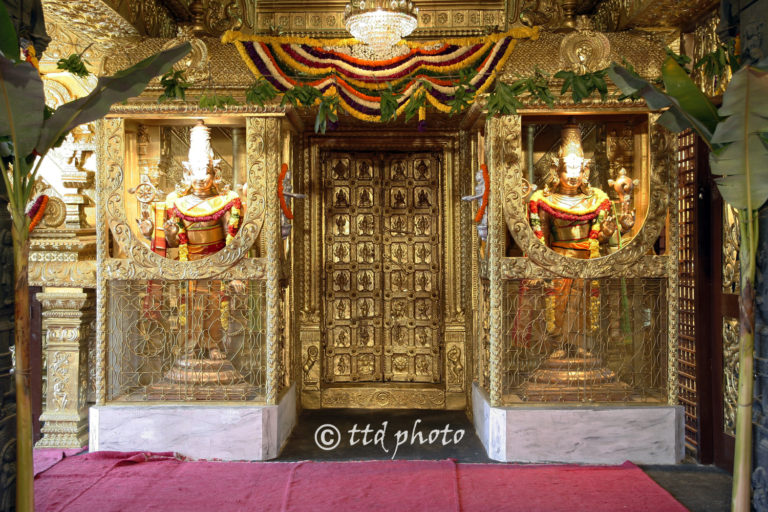Table of Contents
ToggleBangaru Vakili - Golden Doorway
It is interesting to note that there is an image of Dwara-Lakshmi on the upper threshold of the Bangaru Vakili - Golden doorway.
It is one of the eight images of Goddess Lakshmi to be present in a Vaikhanasa temple as prescribed by Vaikhanasa Agama’s text Prakeernadhikara. The same image can also be found in the arches of the Silver entryway (Vendivakili) and the DhwajaSthambha mandapa.
The golden archway is flanked by the statues of Jaya and Vijaya, the dwarapalakas. These are magnificently carved in bronze and awe-inspiring. Jaya and Vijaya were enclosed in a gold-plated enclosure with lattices during the administrative period of Mahant Prayaga Dasa (1901 -1933 ).
Thus it can be distinctly seen that the usual stone dwarapalakas regularly present in Dravidian temples are not seen here. After a blissful Darsan of the Lord of Seven Hills, the devotee moves out of the shrine, by passing the huge temple bells on his right.

Beautiful Carvings
These gold-plated door frames have beautiful creeper carvings. In the middle portion of the upper threshold, towards downwards we can see the carving of bloomed lotus. Similarly outside of the upper threshold has carvings of elephants worshipping Lakshmi seated on a lotus.
The rock frame is fitted with two wooden doors. These two doors have quadrangular borders made from wooden ingots. In each border, we can see the carving of Vishnu.
From the top, there are four carved borders in a row.
- The first one has Chakram,
- the second one has Lord Venkateswara,
- the third one has seated Maha Vishnu, and
- the fourth one has Sankhu.
In the second row, we can see the carved figures of Vasudeva, Sankarshana, Pradyumna, and Aniruddha in the same order.
Again in the 3rd, 4th, and 5th rows the following carvings are there in a row.
- 3rd row: 1. Kesava 2. Narayana 3. Madhava 4. Govinda
- 4th row : 1. Vishnu 2. Madhusoodana 3. Trivikrama 4. Vamana
- 5th row : 1. Sridhara 2. Hrishikesa 3. Padmanabha 4. Damodara
- In the last three rows i.e., 6th and 7th rows there are eight borders.
- The first and the fourth border of the 8th row have carvings of Avatars i.e., Lord’s incarnations.
Padlocks and Locking System
In the second and the third border of row eight to close the doors, padlocks with iron chains have been fixed.
The other end of the chain will be attached to the threshold hook. There are three bolts. To the upper one as well as the lower one temple authorities have locking provision. To the middle bolt the chief priest will use his lock and take the key with him to his quarters, after locking. There is one more locking system. These doors have some circular openings.
Through these holes, by using a crooked pole they lock the door by pulling a rod from the outside and open the inside rod by pushing it from the outside. This type of locking and opening is an art in itself. This is a hereditary one known to the family of Priests.
Tallapaka Annamacharyulu
About these doors made of gold, there is a mention by Tallapaka Annamacharyulu who belonged to the 15th century A.D. In one of his devotional songs, he says that by standing at these glittering doors I had a very good darshan of Lord Venkateswara. It seems, no one knows how many times, as and when the gold plates required new plates, they are provided.
As per the available records Mahant Dharma Das had provided new gold plates in the year 1884. In the year 1958, the Maha Samprokshanam was performed in the upper dome of “Ananda Nilaya”. At that time new plates were fixed to these doors.
Since time immemorial saints like Brahmendra have walked through these golden doors. Sanaksananda like celestial beings would have patiently waited here to have darshan of Lord Venkateswara. Many Alwar Saints, Hari Dasa devotees like Purandara and other saints of Karnataka, Tallapaka poets like Annamacharya, his sons and grandsons, and sacred devotees like Tarigonda Vengamamba have visited this famous temple to have the darshan of Lord Venkateswara.
Not only saints, and kings but umpteen emperors have visited this temple. Being fortunate ones even we have the unique unparalleled opportunity to walk through these golden doors. We have to thank our stars and the Lord for making us visit this temple and have the darshan of Lord Venkateswara.
Govinda! Govinda!! Govinda!!!
